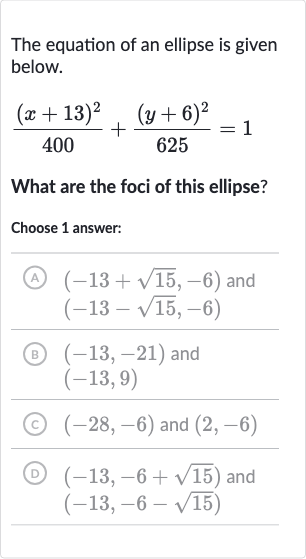Full solution
Q. The equation of an ellipse is given below.What are the foci of this ellipse?Choose answer:(A) and (B) and (C) and (D) and
- Ellipse Equation: The equation of an ellipse is given by:To find the foci of the ellipse, we need to identify the major and minor axes. The denominators of the fractions represent the squares of the semi-major and semi-minor axes lengths. The larger denominator corresponds to the square of the semi-major axis length, and the smaller denominator corresponds to the square of the semi-minor axis length.
- Identifying Axes: In the given equation, the denominator is larger than , which means that the semi-major axis is along the y-axis. The length of the semi-major axis is the square root of , which is . The length of the semi-minor axis is the square root of , which is .
- Calculating Semi-Major and Semi-Minor Axes: The foci of an ellipse are located along the major axis at a distance 'c' from the center, where 'c' is found using the equation , where 'a' is the length of the semi-major axis and 'b' is the length of the semi-minor axis.
- Finding 'c': We calculate 'c' using the lengths of the semi-major and semi-minor axes:
- Determining Center of the Ellipse: The center of the ellipse is at the point , as indicated by the terms and in the equation. Since the major axis is along the y-axis, the foci will be located at .
- Calculating Foci: Substituting the value of into the coordinates of the foci, we get:Foci: and Simplifying the coordinates, we get:Foci: and
More problems from Compare linear, exponential, and quadratic growth
QuestionGet tutor help
QuestionGet tutor help
QuestionGet tutor help
QuestionGet tutor help
QuestionGet tutor help
QuestionGet tutor help
QuestionGet tutor help

